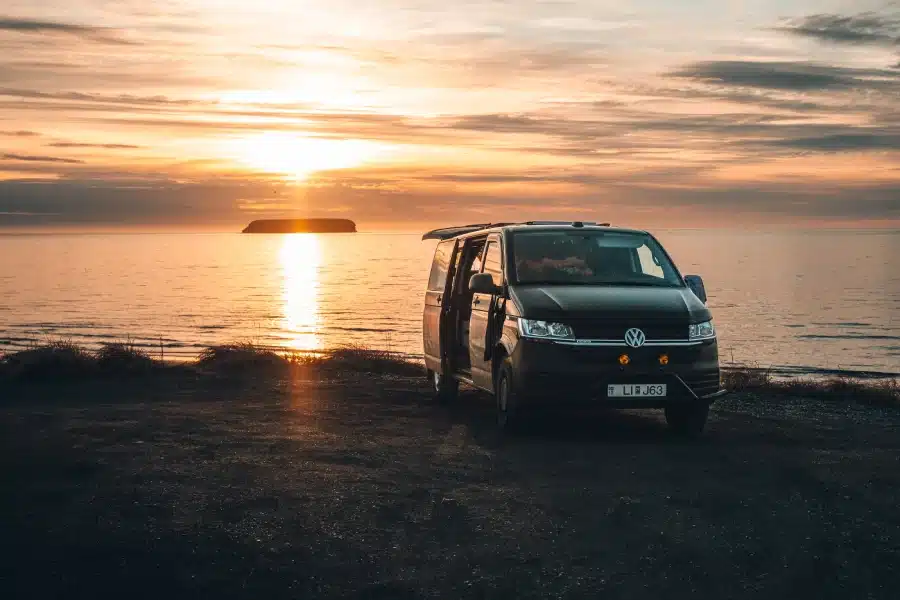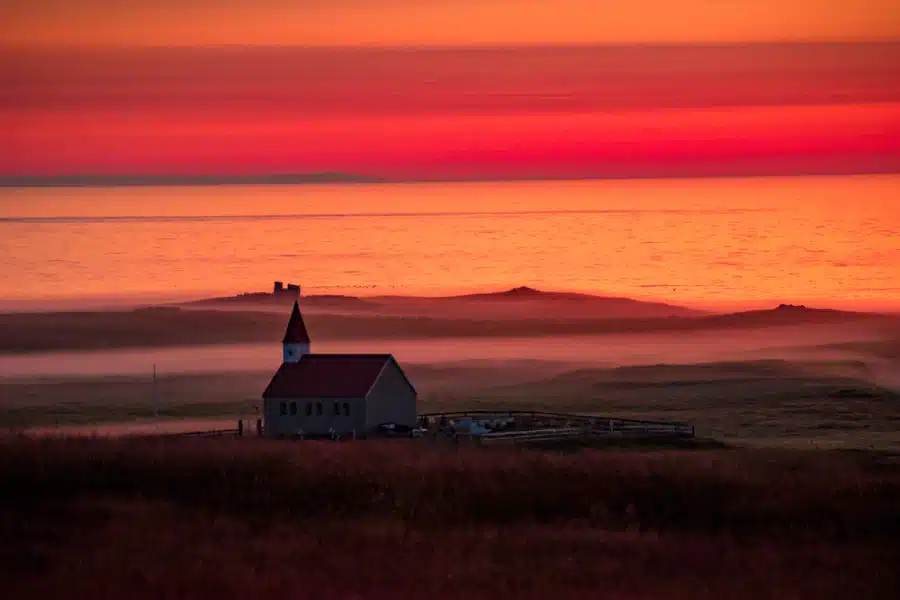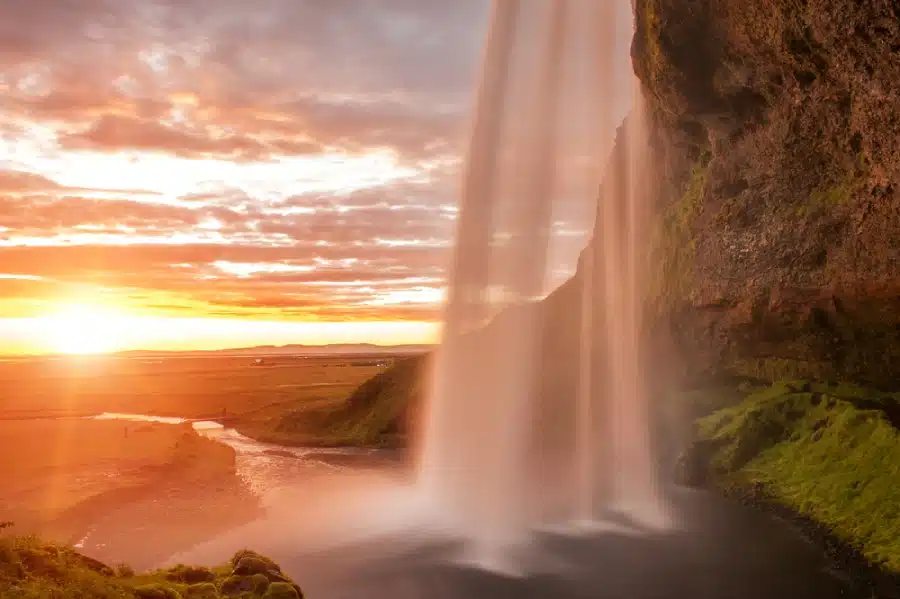Experience the Midnight Sun in Iceland, a unique natural phenomenon where the sun barely sets from mid-June to late June. Enjoy the longer days to explore Iceland natural wonders during your road trip. Plan your trip around the Summer Solstice for the best experience.
Main Points:
- Midnight Sun occurs in mid to late June.
- Sun is visible around the clock due to Iceland’s location and Earth’s tilt.
- Best seen around the Summer Solstice.
- Visit northern Iceland, mountain peaks, or the Golden Circle route.
- Iceland has mild summer temperatures, pack accordingly.
- Enjoy activities like twilight golfing and midnight whale watching.
- Booking a Cozy Campers vans mean you can explore more of Iceland during the extended days.
There are plenty of reasons to visit Iceland. From chasing the Northern Lights to experiencing the power and majesty of our country’s many active and dormant volcanoes, there truly is something for everyone.
Here’s one more natural spectacle that’s incredibly easy to see and enjoy, as long as you visit Iceland at the right time: the Midnight Sun.
In Iceland, the Midnight Sun refers a roughly two-week period when the sun is visible or almost visible in the sky around the clock. From about the middle of June through the month’s end, the sun never fully sets.
The Midnight Sun is an incredible experience that’s best seen in person to be believed and enjoyed. It means more daylight, helping you get the most out of your trip! That’s whether you’re staying close to Reykjavik or traveling across the country on the Ring Road.
Want to learn more about the Midnight Sun in Iceland? You’re in the right place. We’ll cover why these never-ending days happen, the best place to see the Midnight sun in Iceland, and so much more. Let’s get going!

What is the Midnight Sun in Iceland? What Causes It?
In Iceland and in other areas that experience it, the Midnight Sun is a natural phenomenon that comes about for two key reasons. As Encyclopedia Britannica explains, these are:
- The location of these areas on the Earth. The true Midnight Sun, 24 hours of sunlight, is seen within the Arctic and Antarctic. While mainland Iceland sits outside the Arctic Circle, it experiences a near Midnight Sun effect where the sun technically sets but never completely stops illuminating the sky for a few weeks each year.
- The tilt of the Earth’s axis as it relates to the planet’s orbit. In the summer, the Earth’s axis tilts toward the sun, providing more exposure to it.
The farther away from the Arctic or Antarctic you get, the less pronounced this effect is. In fact, it’s the exact same process that causes longer days in summer and shorter days in winter across the globe.
In Iceland, we enjoy extended daylight throughout the summer months. While there is certainly a peak season for the Midnight Sun effect, it gives us longer days each summer.
The term “Midnight Sun” in Iceland is generally used to refer to extended periods of sunlight, especially in casual conversation. However, the formal definition of the Midnight Sun is when the official sunset doesn’t occur until after midnight of the following day.
Regardless of the time of the sunset, the summer months in Iceland are full of especially long days. They make it easier to see more, do more, and get the most out of your vacation.

When is the Midnight Sun in Iceland?
It may not be surprising to hear that the Midnight Sun’s effects in Iceland are at their strongest around the Summer Solstice. This event represents the point at which the Earth’s axis has achieved its greatest tilt toward the sun. The day on which it happens has the longest period of daylight and the shortest period of night of the year, as Royal Museums Greenwich explains.
The Summer Solstice always falls on June 20, 21, or 22 in the Northern Hemisphere. In 2024, it occurs on June 20. In 2025, the Summer Solstice happens on June 20 as well.
So, when is the Midnight Sun in Iceland? The absolute peak occurs on June 20 for the next few years. However, you can still have a similar experience by visiting Iceland in the week before and after the Summer Solstice. This period has the shortest technical sunsets and the sky is still clearly illuminated to a degree by the sun’s rays.
More broadly, the sun barely sets in Iceland between May and August, as Guide to Iceland points out. There is faint illumination across the summer months at night, along with exceptionally long days.
Remember that weather conditions can affect the Midnight Sun in Iceland. Rainy and cloudy days can make it difficult to notice the extended twilight that stops short of a complete sunset.
Our suggestion? Plan a trip of at least several days and rent one of our safe, stylish, and cozy campers! That way, you can travel across the country and enjoy the Midnight Sun, even if it’s cloudy and overcast in some areas.

Celebrating and Enjoying the Midnight Sun in Iceland
The incredibly long stretches of daylight in Iceland come with a cost, so to speak. Our days are exceptionally short during the Winter Solstice and, to a slightly lesser extent, across the winter.
That’s the time when the Earth tilts the farthest away from the sun from our country’s perspective. It means very short days, with just four or five hours of light during December and January.
So, it might not be surprising to hear that we like to celebrate the many hours of daylight we enjoy in the summer! That includes the traditional holiday of Jónsmessa, which falls on June 24.
Traditional beliefs related to this Midnight Sun holiday include cows suddenly gaining the power to speak like people and seals turning into humans, as Visit Iceland explains. You’ll find local festivals and community events, especially in more populated areas, and a general celebratory attitude across the country.
One of the best ways to enjoy the Midnight Sun during your trip is simply to build it into your schedule.
You can visit many of our country’s amazing natural attractions around the clock. There are special offerings from businesses, too, ranging from golfing in the twilight to midnight whale watches. And, when you rent one of our campers, you’re in charge of your entire itinerary.
What are the Best Places to See the Midnight Sun in Iceland?
Great news: You don’t have to be anywhere in particular to enjoy the Midnight Sun in Iceland! The effects of the long daylight are clearly visible across our country.
That said, you may want to visit the northern part of Iceland during this season. The Midnight Sun is even more powerful the farther north you travel. The island of Grimsey hosts a Summer Solstice Festival each year.
You can also experience incredible ultra-late sunsets and extra-early sunrises from mountain peaks and all along the coast.
Finally, consider touring the Golden Circle route along the interior of the country. There are waterfalls, geysers, national parks, and more, as Visit Iceland explains.
Here’s an insider tip: The extended daylight makes it easy to avoid the crowds at sites along the Golden Circle route and everywhere in the country. You can visit nearly any attraction you’re interested in later in the day or earlier in the morning to skip the largest crowds!
These are all great ways to make the most of your trip during the Midnight Sun season in Iceland.

Preparing for Your Trip to Iceland in the Midnight Sun Season
Iceland’s summers are mild compared to much of the US and Europe. Daily mean temperatures are around 50 degrees Fahrenheit in June, and the very hottest days can reach into the mid-70s.
So, while you shouldn’t pack for a tropical vacation, you can keep your luggage light. These temperatures mean you can comfortably move around in shorts, pants, skirts, and a light top. It’s always a good idea to bring a light jacket and a waterproof shell, but you can leave your heavy coats and fleece-lined layers at home.
Here’s one thing you should definitely consider packing: an eye mask to help block the sun while you try to sleep!
Frequently Asked Questions about Iceland’s Midnight Sun
Does Iceland Have the Midnight Sun?
Yes! For about two weeks each year in mid and late June, Iceland experiences the Midnight Sun. The sun doesn’t set until after midnight the following day. For much of the summer, daylight is present a strong majority each day, too.
During What Months is it Completely Dark in Iceland?
Iceland always has some amount of sunlight, even during winter months with the shortest days. During December and January, days can be as short as five hours! It’s never completely dark in Iceland, although it gets close.
How Long is it Dark in Iceland in July?
The sun is in the sky for roughly 20 hours during most days in July. That means very short nights and a sense of twilight even long after the sun officially sets.
In What Part of Iceland Does the Sun Never Set?
Most of Iceland sits outside the Arctic Circle and its zone of seasonal 24-hour sunlight. However, Icelandair explains that Isafjordur in northwest Iceland and the northern island of Grimsey both experience 24/7 sunlight for a time each summer.
Enjoying the Midnight Sun in Iceland to its Fullest!
Cozy Campers means comfortable, stylish, and safe camper vans for your trip. Take advantage of all the daylight hours and enjoy all that Iceland has to offer.
With this combination of vehicle and lodging, you can save money, make your own schedule, and enjoy your trip on your terms. We offer everything from budget camper options to 4×4 camper vans for safely navigating the F-roads that traverse Iceland’s mountainous interior.
Travel with the Coziest Camper Rental in Iceland!
Back to blog